Soekarno–Hatta International Airport
| Soekarno–Hatta International Airport Bandar Udara Internasional Soekarno–Hatta | |||||||||||||||||||
|---|---|---|---|---|---|---|---|---|---|---|---|---|---|---|---|---|---|---|---|
 | |||||||||||||||||||
 | |||||||||||||||||||
| Summary | |||||||||||||||||||
| Airport type | Public | ||||||||||||||||||
| Owner | Government of Indonesia | ||||||||||||||||||
| Operator | PT Angkasa Pura II | ||||||||||||||||||
| Serves | Greater Jakarta | ||||||||||||||||||
| Location | Tangerang, Banten, Indonesia. | ||||||||||||||||||
| Opened | 1 May 1985 | ||||||||||||||||||
| Hub for | |||||||||||||||||||
| Elevation AMSL | 32 ft / 10 m | ||||||||||||||||||
| Coordinates | 6°07′32″S 106°39′21″E / 6.12556°S 106.65583°ECoordinates: 6°07′32″S 106°39′21″E / 6.12556°S 106.65583°E | ||||||||||||||||||
| Website | http://www.soekarnohatta-airport.co.id/ | ||||||||||||||||||
| Maps | |||||||||||||||||||
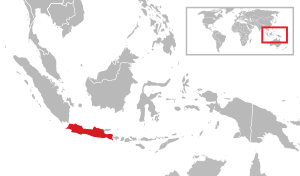 Java region in Indonesia | |||||||||||||||||||
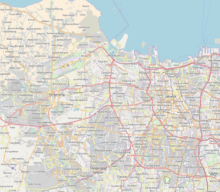 CGK Location of airport in Banten / Indonesia 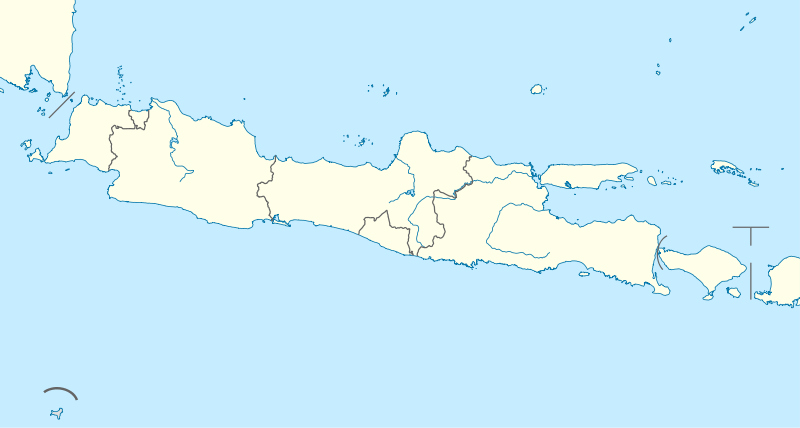 CGK CGK (Java)  CGK CGK (Indonesia) 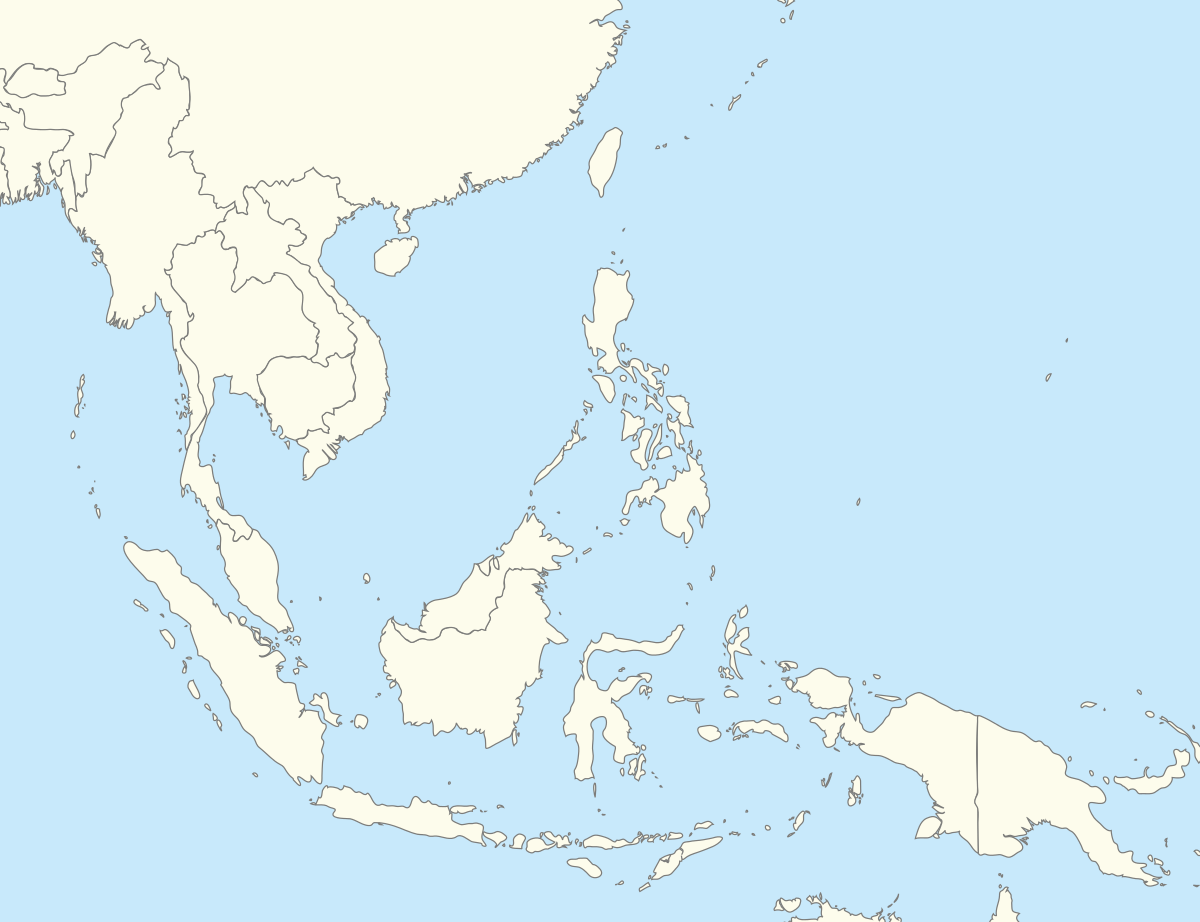 CGK CGK (Southeast Asia) | |||||||||||||||||||
| Runways | |||||||||||||||||||
| |||||||||||||||||||
| Statistics (2017) | |||||||||||||||||||
| |||||||||||||||||||
|
Source: List of the busiest airports in Indonesia,[3] Passenger and Aircraft Movements from ACI[4] Cargo from Angkasa Pura II Airports Company[5] | |||||||||||||||||||
Soekarno–Hatta International Airport (Indonesian: Bandar Udara Internasional Soekarno–Hatta) (IATA: CGK, ICAO: WIII), abbreviated SHIA[6] or Cengkareng airport, hence IATA designator "CGK", is the primary airport serving the Greater Jakarta area on the island of Java in Indonesia. Named after the first president and vice-president of Indonesia, Soekarno and Mohammad Hatta, the airport is located at Benda, Tangerang, 20 km northwest of central Jakarta. It is the busiest, largest airport in Southeast Asia, the busiest in the southern hemisphere and one of the busiest airports in world. Together with the 2nd Jakarta Halim Perdanakusuma International Airport, it served over 70 million passengers of Greater Jakarta in 2017.[7]
The airport was ranked as 17th busiest airport in the world by Airports Council International in 2017.[8] According to air travel intelligence company OAG, the airport ranked as the 7th most connected airport in the world & ranked first as 'megahub' airport in Asia-Pacific region as per connectivity index, ahead of Japan's Tokyo Haneda Airport and Australia's Sydney Airport.[9] The airport ranked as the 7th most connected airport as 'megahub' in the world in 2017 again by air travel intelligence company OAG.[10]The airport ranked as the 2nd most connected Low-Cost Megahub airport as 'megahub' in the world in 2018 by air travel intelligence company OAG.[11]
The airport commenced domestic operations in 1985 replacing the old over capacity Kemayoran Airport. The airport was expanded in 1991 to replace Halim Perdanakusuma International Airport for international flights, which still serves domestic charter, VIP, private flights, and re-opened as second commercial airport for domestic flights to relieve pressure over Soekarno-Hatta airport that is currently running over capacity.
The airport often struggles to accommodate all flights at its current limit of 81 aircraft movements per hour.[12] Although over capacity, after a survey from 23 April to 3 May the Airport Council International (ACI) stated on 4 May 2012 that Soekarno–Hatta International Airport is being operated safely.[13] The two existing runways suffer from pavement and strength issues, which limits the airport's capacity to serve large aircraft. To reduce congestion and to achieve a target to handle 100 flights/hour, works for a 3rd runway is currently going on, which is expected to open in 2018. Upgrading of existing two runways are almost completed for safe operation and to accommodate wide-bodied aircraft at the airport.[14] The airport will be able to serve 100 million passengers annually by 2025 after completion of ongoing development work.[15]
History
Used between 1928 and 1985, Kemayoran Airfield was considered unsatisfactory because it was too close to the major Halim Perdanakusuma Indonesian military airport. The civil airspace in the area became increasingly restricted, while air traffic increased rapidly, posing problems for international air traffic. In 1969, a senior communication officers meeting in Bangkok expressed these concerns.

In the early 1970s, with the help of USAID, eight potential locations were analyzed for a new international airport, namely Kemayoran, Malaka, Babakan, Jonggol, Halim, Curug, South Tangerang and North Tangerang. Finally, the North Tangerang site was chosen; it was also noted that Jonggol could be used as an alternative airfield. Meanwhile, as an interim step, the Indonesian government upgraded the Halim Perdanakusumah airfield for use for passenger services. The old Kemayoran site was closed in 1985, and the land was later used for commercial and housing purposes.[16]
Between 1974 and 1975, a Canadian consultant/consortium, consisting of Aviation Planning Services Ltd., ACRESS International Ltd., and Searle Wilbee Rowland (SWR), won a bid for the new airport feasibility project. The feasibility study started on 20 February 1974, with a total cost of 1 million Canadian dollars. The one-year project proceeded with an Indonesian partner represented by PT Konavi. By the end of March 1975, the study revealed a plan to build three inline runways, three international terminal buildings, three domestic buildings and one building for Hajj flights. Three stores for the domestic terminals would be built between 1975 and 1981 at a cost of US$465 million and one domestic terminal including an apron from 1982–1985 at a cost of US$126 million. A new terminal project, named the Jakarta International Airport Cengkareng, began.[17]
Design
The airport's terminal 1 and 2 was designed by Paul Andreu, a French architect who also designed Paris–Charles de Gaulle Airport. One of the characteristics of the airport is the incorporation of the local architecture into the design, and the presence of tropical gardens between the waiting lounges. These unique characteristics earned the airport the 1995 Aga Khan Award for Architecture.[18] The runways run northeast–southwest. There are two parallel runways, on the north and south side. The airport terminal took the plan of spanning fan, with the main entrances of terminals connected to a series of waiting and boarding pavilions via corridors. These waiting and boarding pavilions are connected to the airplanes through boarding bridges. Terminal 1 is in the southern side of the airport, while Terminal 2 and 3 are on the north side.
The airport concept is described as "garden within the airport" or "airport in the garden", as tropical decorative and flower plants fill the spaces between corridors, waiting and boarding pavilions. The boarding pavilions demonstrate local Indonesian vernacular architecture, particularly the roof, in the Javanese stepped-roof pendopo and joglo style. The interior design displays the diversity of Indonesian art and culture, with ethnic decorative elements taken from wooden carvings of Java, Bali, Sumatra, Dayak, Toraja to Papua. Another example is the railings of stairs, doors and gates, which show the kala-makara (giant head and mythical fish-elephant creature) theme typical in ancient Indonesian temples such as Borobudur. Terminal 3, however, has a different architectural style—unlike the ethnic-inspired Indonesian vernacular architecture of terminals 1 and 2, terminal 3 uses the contemporary modern style of large glass windows with metal frames and columns.
Project phases
To allocate the land and also determine the provincial border, time was needed. Authorities at Amsterdam Schiphol airport were consulted about the airport plans, and concluded that the proposal was rather expensive and over-designed. The cost rose because of using a decentralized system. The centralized system was seen as a more suitable option.
The team chose a decentralized system similar to Orly Airport, Lyon Satolas, Hannover Airport and Kansas City Airport due to its simplicity and effectiveness.
On 12 November 1976, the building project tender was won by the French Aeroport de Paris.
On 18 May 1977, the final design was agreed on by the Indonesian government and Aeroport de Paris with a fixed cost of about 22,323,203 French francs and Rp177,156,000 equivalent to 2,100,000 francs. The work was scheduled to take 18 months. The government appointed PT. Konavi as the local partner. The plan included 2 runways with taxiways, one access road in the east and one in the west (closed to public use) for airport services, 3 terminals capable of accommodating 3 million passengers per year, and 1 module for international flights and 2 for domestic. "An airport inside a garden" was chosen as the design idea.
On 20 May 1980, a four-year contract was signed. Sainraptet Brice, SAE, Colas together with PT. Waskita Karya were chosen to be the developers. Ir. Karno Barkah MSc. was appointed the project director, responsible for the airport's construction.[19]
On 1 December 1980, the Indonesian government signed a contract for Rp. 384.8 billion with developers. The cost structure was: Rp140,450,513,000 from the state budget, 1,223,457 francs donated by France and US$15,898,251 from the USA.
On 1 December 1984, the airport structure was completed.
The new airport opened on 1 May 1985 for domestic flights.
The second circular terminal was opened on 1 May 1991 for international operations.
| Phases of Soekarno–Hatta International Airport Project | ||||
|---|---|---|---|---|
| Phase | Year | Description | Status | |
| Phase 1 | 1985 | Opening of Terminal 1 with a capacity of 9 million passengers per annum | Completed | |
| Phase 2 | 1991 | Opening of Terminal 2 with a capacity of 18 million passengers per annum | Completed | |
| Phase 3 | 2011 | Construction of Terminal 3 phase 1 with a capacity of 22 million passengers per annum | Completed | |
| Refurbishing of Terminal 2 to increase capacity to 53 million passengers per annum | In progress | |||
| Fully built new Freight Terminal | In progress | |||
| Phase 4 | 2017 | Completion of Terminal 3 with a capacity of 43 million passengers per annum | Completed | |
| Construction of Airport Railway | Completed | |||
| Construction of third runway | In progress | |||
| Fully built integrated building | In Progress | |||
| Construction of Terminal 4 | Pending | |||
| Phase 5 | 2022 | Refurbishment of Terminal 1 to increase capacity to 62 million passengers per annum | Pending | |
Plans
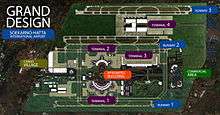
The capacity of the airport is increased from 22 million passengers per year to 62 million per year during 2014 to 2017, but the airport handled more than 63 million passengers in 2017. Therefore, plans to build 4th passenger terminal is already underway. The airport is being implementing new theme "Modern Airport With Traditional Sense" for the project. Angkasa Pura II, as the operator, designed Soekarno–Hatta Airport to have 3 passenger terminals, 1 new freight terminal (cargo village) and an 'Integrated Building' (designed to unite terminal one and two). Also, there will be an increase in apron capacity from 125 airplanes to 174 airplanes. By 2015, additional upgrades are expected to increase the airport's capacity to 75 million passengers.[20] An airport train from Manggarai Station and a people mover for ground transportation to/from and inside the airport are also in planning.
In the first stage, Terminal 3 is expanded. Terminal 1 and Terminal 2 will be integrated with green walls and the airport will have a convention hall, shopping center, hotel, playground, recreational facilities and parking area for 20,000 vehicles.[21]
To anticipate a surge in passenger numbers, at least a ten percent increase each year, the government is preparing to build a third runway. This was planned to be completed in 2019. If the airport has 3 runways, the service capacity will rise to 623,420 movements per year and it will be able to anticipate growth at least until 2030. The expansion will use about 1,000 hectares (2,500 acres) from 10 villages in the Teluk Naga and Kosambi subdistricts.[22][23] Once completed, the third runway would increase Soekarno-hatta's handling capacity to 114 aircraft movements per hour from the current 81.[24] The expansion plan has been rejected by Tangerang Municipal Government because the residents living around the airport wouldn't be able to earn income for their family. The local government offered another location such as in Balaraja, but Angkasa Pura II corporate secretary said that building a new airport would not be an easy task, as it requires a thorough study.[25] Finally, Angkasa Pura II only use 134 hectares land and appraisal will be used for buy the land.[26] It can be done due to new design for third runway is cross-runway between runway-1 and runway-2, instead of 3 parallel runways.
To accommodate 86 aircraft movements per hour from current 72 movements per hour, so since 2016, the airport authority is developing east cross taxiway with cost Rp 1,150 billion ($86.1 million) to connect existing runway-1 and runway-2 and predicted can be used in 2018.[27]
Terminals
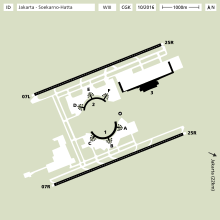
The land area of the airport is 18 square kilometers (6.9 sq mi). It has two independent parallel 3,600-meter (11,800 ft) long runways connected by two cross taxiways. There are three main terminal buildings; Terminal 1, Terminal 2 and Terminal 3. The airport has a freight terminal for domestic and international cargo.
After renovations and expansions of Terminal 3, current capacity of Soekarno–Hatta is 51 million,[28] but the airport served 54 million passengers in 2015, making it the 18th busiest airport in the world, and the busiest airport in the Southern Hemisphere. There are nonstop flights to a large number of destinations in Asia and Australia, and several flights to Europe daily, ranking as the 17th most connected airport in the world, and the largest megahub in Asia according to OAG.[29]
The airport operator also renovating Terminal 1 and Terminal 2, which will cost Rp 3.2 trillion ($235.2 million). Renovation of Terminal 1 is scheduled for completion in June 2019, while Terminal 2 in August 2019. The revitalization project is expected to double the number of passengers of the two terminals up to 36 million a year.[30] By late 2018 Terminal 1 will become a domestic low-cost carrier terminal (LCCT), while Terminal 2 will become an international low-cost carrier terminal (LCCT) and Terminal 3 will become a full-service terminal for both domestic and international flights.[31] The airport operator AP II has undertaken plan to build a fourth terminal at Soekarno-Hatta, which is expected to be completed by 2022.[32]
Terminal 1
Terminal 1 is the first terminal built, finished in 1985. It is located on the south side of the airport, across from Terminal 2. Terminal 1 has 3 sub-terminals, each equipped with 25 check-in counters, 5 baggage carousels and 7 gates. It has the capacity to handle 9 million passengers per annum.
The gates in Terminal 1 have a prefix of A, B or C. The gates are A1–A7, B1–B7 and C1–C7. In the newest masterplan, Terminal 1 will have its capacity increased to 18 million passengers per annum. Terminal 1 is used for domestic flights except for those operated by Garuda Indonesia, Sriwijaya Air, NAM Air, Indonesia AirAsia. Terminal 1A is home to Lion Air domestic flights (except to Sumatra & Bali). Terminal 1B is home to Lion Air domestic flights (only to Sumatra and Bali) and Xpress Air. Terminal 1C is home to Batik Air (domestic flights), Citilink (domestic flights) and other Indonesian domestic flights. This terminal will be converted into a domestic low-cost carrier terminal (LCCT) by early 2019.
Terminal 2
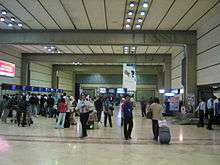
Terminal 2 is the second terminal built, completed in 1991, and is located on the west-northern side of the airport, across from Terminal 1. Like Terminal 1, it has three sub-terminals, labeled as D, E and F, each of which has seven gates and 25 check-in counters. Although some airlines were still serving international routes from terminals 2E and 2D, all international flights have been gradually moved to Terminal 3, after that Terminal 2 would cater only to umrah (minor haj) flights and will be converted into a international low-cost carrier terminal (LCCT) by early 2019.[33].[34] Terminal 2F is home to Sriwijaya Air, NAM Air, Indonesia Airasia and Indonesia AirAsia X domestic flights.[35][36]
Terminal 3
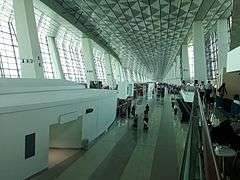
The newly built Terminal 3 was opened in 2016, which is located on the east-northern side of the airport. The terminal has a different style than terminals 1 and 2, using an eco-friendly contemporary modern design with a traditional sense. It currently houses all Garuda Indonesia flights, both domestic and international, as well as all international flights from China Airlines, China Southern,[37] Korean Air, Indonesia AirAsia, Indonesia AirAsia X, Saudia, Scoot, Vietnam Airlines and XiamenAir.
The former Terminal 3 was officially opened for international flights on 15 November 2011, when all Indonesia AirAsia flights started using Terminal 3 as its new base for international flights as well as domestic flights.[38] The New Terminal 3 (known as "Terminal 3 Ultimate") was formally opened on 9 August 2016. The floor area of the new terminal covers 422,804 m2 (4,551,020 sq ft)[39] with 10 international gates, 18 domestic gates, 112 check-in counters, 48 jet bridges and 10 bus gates.[40][41] It is slated to be larger than Changi Airport Terminal 3, Singapore which is the benchmark for SHIA.[42][43] There is a Tourist Information Center at Terminal 3 Ultimate to serve international tourists.[44] At present the New Terminal 3 has no connection with the building of the old Terminal 3. The older Terminal 3 will be renovated with a connection to be built between the old and new terminals.
Terminal 3 is equipped with BHS level 5 to detect bombs, an Airport Security System (ASS) which can control up to 600 CCTVs to detect faces who are available in the security register, an Intelligence Building Management System (IBMS) which can control uses of water and electricity (ecogreen), rain water system to produce clean water from rain, a recycled water system to produce toilet water from used toilet water, and illumination technology control to illuminate the terminal depending on the weather surrounding the terminal.[45] Terminal 3 will be able to serve 60 airplanes from the current 40 airplanes.[46]
Terminal 4
Angkasa Pura II- the operator of the airport has undertaken a plan to build Terminal 4, which will be located on the north side of runway 2.[47][48] The terminal will be located north of Terminal 3, and northeast of Terminal 2, which is also on the north of the airport. Terminal 4 will be built at the 4th stage. The terminal will be designed in the form of 'H' and use eco-friendly and modern design, same as Terminal 3 design.The terminal is expected to be operational by 2022.
Freight Terminal
The freight terminal is located on the east side of terminal 1. This terminal was used to handle cargo at the Soekarno–Hatta International Airport, both domestic and international cargo. In the newest master plan, the freight terminal will move to the west side of terminal 2 and have a larger capacity than the current terminal.
Airlines and destinations
Passenger
Cargo
Traffic and statistics
Busiest routes
Jakarta – Singapore is one of the world's busiest international air routes ; passenger numbers of this route is growing fast. It was the 2nd busiest international route in Asia after Hong Kong – Taipei in 2015.[62] Singapore Airlines alone operates more than 70 weekly flights between Jakarta & Singapore. Jakarta Soekarno–Hatta–Surabaya route is ranked 9th busiest in the world by IATA in 2016.[63] Jakarta — Singapore and Jakarta — Kuala Lumpur routes are ranked within the top ten of world's busiest international air routes in 2018.[64]
New traffic procedure
To ease congestion, the airport authority implemented a new traffic procedure, the 72 Improved Runway Capacity (IRC 72), to handle 72 planes per hour. This limited a plane to 30–45 minutes only for arrival and unloading of passengers, to allow other planes to use the parking space. Gradually it has been implemented and on 26 June 2014 IRC 72 has been implemented full for the period of 00:00am to 01:30am, 02:00am to 10:00am and 11:30pm to 00:00am with occupancy periods for aircraft are reduced from 110 seconds to 90 seconds of takeoff and from 65 seconds to 50 seconds for landing. The low time is from 04:00pm to 10:00pm with only maximum 32 flights/hour.[65] By 2015, IRC 72 will become IRC 86 with the opening of the new terminal.[66] As a comparison, London Heathrow Airport, which has 2 runways like SHIA, can handle 100 flights per hour, so the target for SHIA has been revised to 92 flights per hour by 2015.[67] As of July 2017, maximum flight frequency at Soekarno–Hatta International Airport had been increased to 81 take-offs and landings per hour to accommodate increasing demand from aviation companies.[68]
Airport facilities
Terminals 1 and 2 were designed to resemble a traditional joglo Javanese construction. The approach has been emphasized by the inclusion of well-maintained gardens located near all boarding areas. Terminal 3 and other new airport buildings use an eco-friendly and modern design.
Aircraft maintenance
Maintenance facilities for aircraft in Soekarno–Hatta International Airport are supported by GMF AeroAsia (Garuda Maintenance Facility). They include 480,000 square meters (5,200,000 sq ft) of built-up structures, including four hangars, a spares warehouse, workshops, utility buildings, a ground support equipment building, chemical stores, an engine test cell, and management offices. In addition, GMF AeroAsia has an apron capable of handling up to 50 aircraft, taxiways, a run-up bay and a waste treatment area, taking up 1,150,000 square meters (12,400,000 sq ft).
Hangar 1 was built in 1991 and was designed for Boeing 747s. It has two full docks and is 22,000 square meters (240,000 sq ft). Hangar 2 is 23,000 square meters (250,000 sq ft) and has 3 aircraft bays. It can perform minor A and B checks. It can hold up to one narrow body and one wide body jet. Hangar 3 is also 23,000 square meters (250,000 sq ft). It normally holds up to 3 narrow body aircraft, but can be configured to hold up to one wide body and one narrow body. It has 7 bays with 4 full docks, 6 roof-mounted cranes and one bay designed for McDonnell Douglas MD-11s, McDonnell Douglas DC-10s, and wide body Airbus A330s aircraft. Hangar 4 is 67,022 square meters (721,420 sq ft). The Hangar 4 was opened in 2015 and was designed for narrow body aircraft like B737s and A320s. It can handle 16 narrow body aircraft in one time.
Golf course
There is a golf course at the Soekarno–Hatta International Airport supported by the Cengkareng Golf Club. The golf course has been open since 1999. It is located on the left side of the airport main gate by the Sheraton Bandara Hotel. The Cengkareng Golf Club is in the 102-hectare (250-acre) Soewarna Business Park at Soekarno–Hatta International Airport. In 2005 and 2008, this golf course was used for Indonesia Open, a part of the PGA European Tour. There are 18 holes in the golf course.
Airport hotel
Soekarno–Hatta International Airport has a hotel, the Bandara International Hotel, managed by AccorHotels. The Bandara International Hotel, which is located on the left side of the main exit road from the airport, has 4 floors with 220 guest rooms. The airport now has other hotels, including budget such as Ibis Styles, Pop! Hotels, Swiss-Belhotel, Orchard Hotel, Swiss-Belinn, Ibis Budget and Amaris as an alternative. Terminal 3 of the airport has a Digital Airport Hotel or Capsule hotel with 120 rooms, which has Alpha-type and Beta-type rooms.[69]
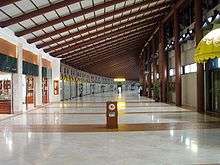
Lounges
There are five airport lounges in the departure area. The Jasa Angkasa Semesta (JAS) Lounge is available for first and business class passengers of Cathay Pacific, Qantas, EVA Air, Saudia, and Singapore Airlines. The Pura Indah Lounge is available for first and business class passengers of Singapore Airlines, KLM, Malaysia Airlines, Emirates, Cathay Pacific, and China Airlines. The new Garuda Indonesia lounge is available for their business class and first class passengers only, as well as GECC and GarudaMiles gold and above cardholders. The BNI Executive Lounge is located next to the Garuda Indonesia Lounge, the lounge serve passengers from all airlines. Other lounges are available outside of the departures area, operated by companies such as Indosat, Sapphire, PT Mandara Jasindo Sena, Telkomsel, and XL Axiata. Since 2013, the only lounge in Terminal 1 was opened named Batik Air Business Class Lounge inside the waiting room C7. The Garuda Indonesia lounge has been moved to Terminal 3 Ultimate.
Shopping area
There are shopping areas available in all terminals at Soekarno–Hatta International Airport. Duty-free shops, souvenir shops, restaurants and a cafeteria can be found there. There is a new "Shopping Arcade" located in terminal 1C. There are no shops in the arrival zones of the terminals.
Reading corners
21 reading corners are located in the waiting rooms of Terminal 2D, 2E and 2F.[70]
WiFi
Three WiFi networks are provided by Lintasarta, Internux (via YelloChat Free WiFi) and Telkom Indonesia at the airport. The three networks allow users to connect to another network if a specific one is operational.
Since November 2013, Terminal 2 has free WiFi covering the whole terminal and free WiFi for Terminal 1 is servicing as of July 2014. Terminal 3 now has free WiFi covering since November 2014.
Smoking garden
To handle the overcrowding of smoking rooms being used, airport authorities has drawn up plans to build a smoking area in a garden near the rest area in Terminal 1A. It was opened in January 2015 and it will be developed to other terminals, if necessary.[71]
Other facilities
The airport contains the head office of Garuda Indonesia, Garuda Indonesia Management Building, located within the Garuda Indonesia City Center.[72] Angkasa Pura II's head office is on the airport property.[73]
Ground transportation
There are several transportation options available for access to the airport: local airport terminal shuttles, train, buses, taxi services of various kinds, and cars. There is free shuttle bus service and people maneuver system Skytrain to connect the terminals of the airport.
Bus
Several bus companies, including the state-owned PrimajasaDAMRI,[74] provide services to various destinations from the airport. Jabodetabek Airport Connexion which consist of Perum Damri, PPD, Big Bird dan Sinar Jaya Megah Langgeng serve routes from the airport to certain malls and hotels in Greater Jakarta.[75] The buses operate from 06.00 to 23.00 with routes:[76]
Travel time to and from the center of Jakarta (at the Gambir railway station) takes around 70 minutes, depending on traffic. Buses to the airport leave from the various terminals in central Jakarta (Gambir) and surrounding areas.
BUS - Shuttle service
| Service | Destination (Soetta Airport,Terminal 1, 2 and 3) | ||
|---|---|---|---|
| Shuttle Airport Bus | |||
| Agramas | Pusat Grosir Cililitan | East Jakarta | |
| Citilink Shuttle | Scientia Square Park | South Tangerang | |
| Citilink Shuttle | SCBD | Central Jakarta | |
| Damri | Bekasi Kayuringin Bus Terminal | Bekasi | |
| Damri | Blok M Bus Terminal | South Jakarta | |
| Damri | Botani Square Mall | Bogor | |
| Damri | Cikarang | Cikarang | |
| Damri | City Mall Cibinong | Cibinong | |
| Damri | East Bekasi | Bekasi | |
| Damri | Gambir Railway Station | Central Jakarta | |
| Damri | Kampung Rambutan Bus Terminal | East Jakarta | |
| Damri | Karawang | Karawang | |
| Damri | Kemayoran | Central Jakarta | |
| Damri | Kota Harapan Indah | Bekasi | |
| Damri | Lippo Karawaci Mall | Tangerang | |
| Damri | Mangga Dua Square Mall | North Jakarta | |
| Damri | Pasar Minggu Bus Terminal | South Jakarta | |
| Damri | Pramuka City | Central Jakarta | |
| Damri | Pulo Gebang | East Jakarta | |
| Damri | Purwakarta | Purwakarta | |
| Damri | Rawamangun Bus Terminal | East Jakarta | |
| Damri | Serang–Cilegon-Merak | Banten | |
| Damri | Summarecon Bekasi | Bekasi | |
| Damri | Tanjung Priok Bus Terminal | North Jakarta | |
| Damri | WTC Serpong | South Tangerang | |
| Primajasa | Bandung Batununggal | Bandung | |
| Primajasa | Bandung Caringin | Bandung | |
| Hiba Utama | Depok Bus Terminal | Depok | |
| Sinar Jaya | Cileungsi Bus Terminal | Bogor Regency | |
| Redwhitestar | Bandung Gedungsate | Bandung | |
| Primajasa RWS | Bandung Diponegoro32 | Bandung | |
JA Connexion Bus
Greater Jakarta Transportation Agency (BPTJ) operates this service, which uses air conditioned buses with comfortable seats and Wi-Fi.[77] The routes are:
- Hotel Borobudur-Hotel Alia-Hotel Luminor-Airport.
- Hotel Aryaduta-Hotel Sari Pan Pacific-Airport.
- Hotel Grand Cemara-Hotel Ibis Thamrin-Hotel Milenium-Airport.
- Hotel Sahid Jaya-Mall Grand Indonesia-Hotel Ascot-Airport.
- Hotel Amaris Thamrin City-Airport.
- Hotel Sahid Jaya Lippo Cikarang-Airport.
- Bogor Trade Mall-Airport.
- Mall Taman Anggrek-Airport.
- Mall Plaza Senayan-Airport.
- Mall ITC Cempaka Mas-Airport.
- Mall Kelapa Gading-Airport.
- Pondok Indah Mall-Airport
- ITC Tanah Abang-Airport.
- Bubulak-Bukit Cimanggu City(Bogor Icon)-Sentul-Airport
Inter-terminal shuttle service
Soekarno–Hatta International Airport provides a free shuttle bus which connects Terminals 1, 2 and 3. Airport shuttle bus can be found at arrival hall of Terminal 1A–1B–1C, on the eastern wing of arrival hall of Terminal 2F and in front of departure hall of Terminal 3
Taxicab
The airport is connected to Jakarta's city center via the Prof. Dr. Sedyatmo Toll Road. There is extensive car parking, including long-stay facilities, at the airport. Various taxi and shuttle services are provided by several operators.
Rail transport
SkyTrain (inter-terminal shuttle service)
Skytrain | |||||||||||||||||||||||||||||||||||||||||||||||||||||||||||||||||||||||||||||||||||||||||||||
|---|---|---|---|---|---|---|---|---|---|---|---|---|---|---|---|---|---|---|---|---|---|---|---|---|---|---|---|---|---|---|---|---|---|---|---|---|---|---|---|---|---|---|---|---|---|---|---|---|---|---|---|---|---|---|---|---|---|---|---|---|---|---|---|---|---|---|---|---|---|---|---|---|---|---|---|---|---|---|---|---|---|---|---|---|---|---|---|---|---|---|---|---|---|
| |||||||||||||||||||||||||||||||||||||||||||||||||||||||||||||||||||||||||||||||||||||||||||||
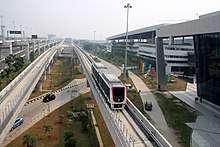
The plan to build an airport automated people mover system to connect Terminals 1, 2, and 3, and the Airport Rail Link Station, was announced in 2013.[78] Starting on 17 September 2017, the people mover, named SkyTrain, is officially opened to connect Terminal 3 and Terminal 2 vice versa, with a headway of 5 minutes. One set of SkyTrain can serve 2x88 passengers. It temporarily operates between 07.00–10.00, 13.00–14.00 and 17.00–19.00.[79]
Airport rail link
Soekarno–Hatta ARS | ||||||||||||||||||||||||||||||||||||||||||||||||||||||||||||||||||||||||||||||||||||||||||||||||||||||||||||||||||||||||||||
|---|---|---|---|---|---|---|---|---|---|---|---|---|---|---|---|---|---|---|---|---|---|---|---|---|---|---|---|---|---|---|---|---|---|---|---|---|---|---|---|---|---|---|---|---|---|---|---|---|---|---|---|---|---|---|---|---|---|---|---|---|---|---|---|---|---|---|---|---|---|---|---|---|---|---|---|---|---|---|---|---|---|---|---|---|---|---|---|---|---|---|---|---|---|---|---|---|---|---|---|---|---|---|---|---|---|---|---|---|---|---|---|---|---|---|---|---|---|---|---|---|---|---|---|---|
| ||||||||||||||||||||||||||||||||||||||||||||||||||||||||||||||||||||||||||||||||||||||||||||||||||||||||||||||||||||||||||||
Soekarno–Hatta Airport Rail Link connects Jakarta city center with the airport. The train takes 45–55 minutes from Manggarai station at South Jakarta to SHIA station. Each train accommodates up to 272 passengers and will serve about 35,000 passengers with 122 trips a day, when fully operational.[80] There is a 15-minute interval between the train departures. As Manggarai station is under renovation, Sudirman Baru station is being temporarily as terminus for the city center.[81] The airport train currently makes 42 trips daily between 3.51 a.m. and 9.51 p.m., departing from Sudirman Baru station in to SHIA, with a stop at Batuceper station. Trips from Soekarno-Hatta to Sudirman Baru runs from 6.10 a.m. to 11.10 p.m., departing every hour.[82] The ticket price for the journey is IDR70 thousand (US$5). Passengers can only book train tickets using credit and debit cards, as well as electronic money via Railink app available for smartphones or vending machines at stations.
An express line between Halim Perdanakusuma Airport and the airport is under planning stage, to be built by an investor as a public–private partnership.[83][84] The express train will take 30 minutes to connect the airports.[85] In early 2015, government changed the fund from participation to not funding at all, so the contract for Rp 28 billion will be revised, including new rail express tariff. The construction of this line has been delayed and completion is now projected to be in 2019 at the earliest.[86]
Accidents and incidents
- On 28 October 1997, a Trigana Air Service Fokker F-28 Fellowship 3000 passenger plane returned to land at Jakarta–Soekarno–Hatta International Airport after the aircraft experienced technical problems two minutes after takeoff. Smoke and severe heat had entered cockpit and the passenger cabin. The airplane sustained damage due to the heat.[87]
- On 23 January 2003, a Star Air Boeing 737 touched down 500 meters (1,600 ft) past the threshold of runway 25L, a little left of the centerline, at a time of heavy rainfall with associated heavy winds. It went off the side of the runway, causing substantial damage to the aircraft's undercarriage and belly.[88]
- 2003 Soekarno–Hatta International Airport bombing – On 27 April 2003, a bomb exploded in terminal 2, departure hall of domestic terminal. The bomb was hidden under a table of a KFC stall and exploded during lunch hours. 10 people were injured in the blast, one 17 year old teenager identified as Yuli was seriously injured. Her legs had to be amputated. Emergency services were rushed to the scene and suspected that the motive of the bombing was due to the Free Aceh Movement, a separatist movement in Aceh. This was proved by the location of the blast, which was located on the domestic passenger hall rather than on the international passenger hall.[89][90][91][92]
- On 11 August 2003, a Garuda Indonesia Fokker F-28 Fellowship 3000R suffered a left main gear collapse after a flight from Surabaya.[93]
- On 9 March 2009, a Lion Air MD-90 overran runway 25L, due to an unstable approach 100 meters (330 ft) before the runway in rainfall and strong winds, in which the aircraft touched down to the left of the centerline. Although its thrust reversers were functioning, it veered to the right, resulting in the aircraft resting 90 degrees off the runway.[94]
- On 5 July 2015, JW Lounge located on Terminal 2E was on fire. More than 30 flights were canceled with hundreds more were delayed.[95]
Awards
In 1995, the landscaping of Soekarno–Hatta airport was awarded by Aga Khan Award for Architecture as one of the best example of integrating the terminal building pavilions, with lush tropical garden harmoniously.[96]
Soekarno–Hatta International Airport was ranked fourth on the Skytrax World's Most Improved Airport 2014 list based on surveys of 12.85 million passengers from 110 countries.[97] Skytrax also ranked Soekarno–Hatta International Airport as a 3-Star Airport.[98]
In 2017, Soekarno–Hatta International Airport was ranked first on the Skytrax World's Most Improved Airport 2017.[99][100]
Picture gallery
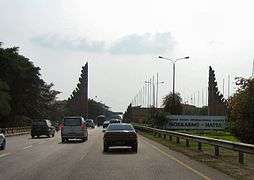 The former main entrance gate at Prof. Dr. Sedyatmo Toll Road
The former main entrance gate at Prof. Dr. Sedyatmo Toll Road- The former site of the statue of Soekarno and Mohammad Hatta
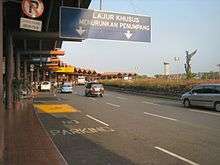 Terminal 2
Terminal 2 Tower
Tower Terminal building with gardens
Terminal building with gardens- Check in desks in terminal 2
- Gate lounge in terminal 2
 Baggage claim at terminal 2
Baggage claim at terminal 2 Arrival Hall terminal 2F
Arrival Hall terminal 2F- The old Terminal 3
See also

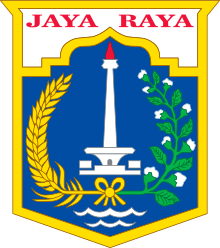

References
- ↑ "Angkasa Pura II: Airports Receive 63 Million Passengers in 2017". Tempo. Retrieved 7 January 2018.
- ↑ "Soekarno–Hatta International airport – Economic and social impacts". Ecquants. Retrieved 14 September 2013.
- ↑ (Persero), PT Angkasa Pura II. "Bandara Changi Terbaik, Soetta Berkembang Pesat - PT Angkasa Pura II". www.angkasapura2.co.id. Retrieved 18 March 2017.
- ↑ "Preliminary 2012 World Airport Traffic and Rankings". Airports Council International. 26 March 2013.
- ↑ PT Angkasa Pura II (Persero). "Halaman Tidak Ditemukan – PT Angkasa Pura II". PT Angkasa Pura II (Persero). Retrieved 18 August 2015.
- ↑ "Bandara Soekarno Hatta Raih Dua Penghargaan". Media Indonesia. 17 May 2011. Archived from the original on 22 May 2011.
- ↑ "Soekarno-Hatta airport serves 63m passengers in 2017". The Jakarta Post. Retrieved 7 January 2018.
- ↑ "Jakarta's Soekarno-Hatta International Airport World's 8th Busiest Airport". Retrieved 27 October 2017.
- ↑ "Soekarno-Hatta named Asia-Pacific's most connected airport". 3 December 2016.
- ↑ "Soekarno-Hatta among world's largest megahub airports in 2017". The Jakarta Post. Retrieved 7 October 2017.
- ↑ "Asia Pacific's leading airports perform strongly on the OAG Megahub International Index 2018". The Star. Retrieved 24 September 2018.
- ↑ "Flight frequency increased to meet increasing demand: Minister". The Jakarta Post. Retrieved 28 July 2017.
- ↑ "ACI: Soekarno-Hatta Aman dan Laik Operasi".
- ↑ "Soekarno-Hatta's 3rd runway to be constructed in 2017".
- ↑ "Soekarno-Hatta airport to serve 100m passengers in 2025". The Jakarta Post. Retrieved 16 April 2018.
- ↑ "Kemayoran Tower – News". Department of Communication, Informatics and Public Relations of Jakarta Capital City. 28 August 2012. Archived from the original on 20 February 2015. Retrieved 4 June 2015.
- ↑ "Riwayat Pembangunan Cengkareng". Angkasa (in Indonesian). No. 4. January 2002. Archived from the original on 22 January 2002. Retrieved 18 August 2015.
- ↑ "Aga Khan Award for Architecture – The Sixth Award Cycle, 1993–1995". Archived from the original on 15 June 2002.
- ↑ "Apa dan Siapa – KARNO BARKAH". Tempo – via Ahmad.web.id.
- ↑ "Major Upgrade for Jakarta Airport". Airport International. 23 July 2012.
- ↑ "Jakarta's airport to be world-class 'aerotropolis'". The Jakarta Post. 25 July 2011. Archived from the original on 4 March 2016.
- ↑ "Govt prepares Soekarno–Hatta Airport expansion". The Jakarta Post. Retrieved 4 June 2015.
- ↑ "Bandara Soeta Butuh Investasi Rp11,7 Triliun". 10 February 2012.
- ↑ "Land acquisition for new Soetta runway in Indonesia stays on track". The Straits Time. Retrieved 11 February 2018.
- ↑ "Tangerang rejects Soekarno–Hatta airport expansion plan". The Jakarta Post. Retrieved 4 June 2015.
- ↑ "Sebanyak 2.459 Bidang di Tangerang Tegusur, Terkait Pembangunan Runway 3 Bandara". 14 October 2016.
- ↑ Rina Atriana (9 February 2017). "2 Runway Bandara Cengkareng Akan Dihubungkan Lewat Timur".
- ↑ "Selamat Datang di Gerbang Indonesia". Kompas.com. Archived from the original on 21 September 2016. Retrieved 2 October 2016.
- ↑ "Soekarno–Hatta airport named Asia's largest megahub". The Jakarta Post. Jakarta. 6 October 2015.
- ↑ "AP II to Spend Rp 3.2t on Soekarno-Hatta Airport Revitalization". Jakarta Globe. Retrieved 11 February 2018.
- ↑ "Soekarno-Hatta Airport's Terminal 1, 2 converted into LCC terminals". The Jakarta Post. Retrieved 10 August 2018.
- ↑ "Land acquisition for new Soetta runway in Indonesia stays on track". The Straits Time. Retrieved 11 February 2018.
- ↑ "Soekarno-Hatta's Terminal 2 to be used for low-cost carriers". The Jakarta Post. Retrieved 23 July 2018.
- ↑ "International flights to move to Soekarno-Hatta Terminal 3 by May". The Jakarta Post. Retrieved 20 June 2018.
- ↑ "BANDARA SOETTA: Sejumlah Maskapai Pindah Terminal Operasi". Bisnis.com. 8 June 2016. Archived from the original on 18 September 2016. Retrieved 12 September 2016.
- ↑ "Sejumlah Maskapai Pindah Terminal di Soetta, Ini Daftarnya!". Dream.co.id. 15 August 2016. Retrieved 12 September 2016.
- ↑ "China Southern Beroperasi di Terminal 3 Bandara Soekarno-Hatta". 28 August 2017.
- ↑ "In Jakarta AirAsia Routes All Flights to Terminal 3". 16 November 2011.
- ↑ Jadi Hadiah Lebaran, Bagaimana Persiapan Terminal 3 Ultimate Bandara Soetta? www.detik.com
- ↑ Penumpang Tiba di Terminal 3 Ultimate Tak Akan Kehujanan dan Kepanasan, Kenapa? www.detik.com
- ↑ Terminal 3 Bandara Soekarno–Hatta Nyaris Rampung, Mei Digunakan www.pikiran-rakyat.com
- ↑ Banu Adikara (27 January 2016). "T3 Ultimate Bandara akan Jadi Terminal Transit".
- ↑ Banu Adikara (27 January 2016). "Pembangunan Terminal 3 Ultimate Sudah 93 Persen".
- ↑ JONIANSYAH HARDJONO (22 June 2017). "Soekarno Hatta Airport Now Have Tourist Information Center".
- ↑ Jabbar Ramdhani (10 June 2016). "Ini Fasilitas Canggih yang Ada di Terminal 3 Ultimate Bandara Soekarno-Hatta".
- ↑ Pingkan Elita Dundu (17 November 2014). "Agar Penumpang Lebih Aman dan Nyaman di Bandara Soekarno-HattaYYY".
- ↑ "Angkasa Pura II Persiapkan Pembangunan Terminal 4 Bandara Soekarno-Hatta".
- ↑ "AP II Ancang-ancang Bangun Terminal 4".
- ↑ https://agent.lionair.co.id/LionAirAgentsPortal/Default.aspx
- ↑ https://agent.lionair.co.id/LionAirAgentsPortal/Default.aspx
- ↑ https://agent.lionair.co.id/LionAirAgentsPortal/Default.aspx
- ↑ https://www.routesonline.com/news/38/airlineroute/278422/china-airlines-hong-kong-jakarta-service-changes-from-july-2018/
- ↑ Sudah Dibuka, Sekarang Citilink Terbang Langsung dari Jakarta ke Banyuwangi
- ↑ "Ethiopian adds Jakarta; Manila service changes in S18". Routes Online. Retrieved 30 July 2018.
- ↑ https://www.garuda-indonesia.com/id/en/news-and-events/garuda-indonesia-discontinue-flight-jakarta-london.page?
- ↑ https://www.routesonline.com/news/38/airlineroute/280178/garuda-indonesia-closes-london-heathrow-bookings-from-late-oct-2018/
- ↑ "Shenzhen Airlines adds Jakarta service from late-Sep 2018". routesonline. Retrieved 4 September 2018.
- ↑ "Expand Freighter Network from May 14th, 2014". ANA Cargo. 30 April 2014. Retrieved 20 May 2014.
- ↑ http://www.asialinkcargo.co.id
- ↑ "Cardig Air Scheduled Timetable". Cardigair.com. Retrieved 1 January 2014.
- ↑ "Qatar Airways Cargo adds Jakarta flights in Aug 2018". Routesonline. 27 July 2018.
- ↑ "Changis busiest routes set to growfurther".
- ↑ "The busiest-route in the world will surprise you".
- ↑ "Singapore-KL route is world's busiest global air link". The Straits Times. Retrieved 29 May 2018.
- ↑ "Soekarno–Hatta Airport Increases Runway Capacity". Tempo.co. 26 June 2014.
- ↑ Maria Yuniar (21 February 2014). "Air Traffic Procedures Restructured". Tempo.co.
- ↑ Ananda Putri (25 April 2014). "Soekarno–Hatta Airport Ready to Serve 72 Flights per Hour". Tempo.co.
- ↑ "Flight frequency increased to meet increasing demand: Minister". The Jakarta Post. Retrieved 28 July 2017.
- ↑ "Soekarno Hatta Airport`s Capsule Hotel Can be Booked Online". Tempo. Retrieved 18 September 2018.
- ↑ "Pojok Baca Kini Hadir di Bandara Soekarno Hatta". 23 July 2013.
- ↑ "Taman Khusus Merokok Dibangun di Bandara". 23 December 2014.
- ↑ "President Susilo Bambang Yudhoyono Officially Opens New Head Office and the Unveiling of New Garuda Indonesia Concept of Service". Garuda Indonesia. 23 July 2009. Archived from the original on 31 December 2010. Retrieved 16 September 2010.
- ↑ "Informasi Perusahaan". Angkasa Pura II. Retrieved 16 September 2010.
Kantor Pusat PT (Persero) Angkasa Pura II Bandara Internasional Jakarta Soekarno–Hatta
- ↑ Atriana, Rina (9 August 2016). "Transportasi di T3 Ultimate Bandara Soetta: Taksi, Damri hingga Shuttle Bus". detikNews (in Indonesian). Retrieved 18 June 2017.
- ↑ Max Agung Pribadi (30 May 2017). "Dari Hotel atau Mal ke Bandara Soetta Bisa Naik Ini".
- ↑ "Blue Bird Luncurkan Bus Bandara Soetta-Jabodetabek dengan Tarif Rp 50000". 30 May 2017.
- ↑ "Airport bus service available at Pondok Indah Mall". The Jakarta Post. Retrieved 29 December 2017.
- ↑ Kurniasih Miftakhul Jannah (27 January 2016). "Kereta Tanpa Masinis di Bandara Soekarno–Hatta Butuh Rp1 Triliun".
- ↑ Yaspen Martinus (17 September 2017). "Skytrain Bandara Soekarno-Hatta Gratis".
- ↑ "Construction of Airport Rail Link to be Completed in March 2017". Tempo. 26 December 2017.
- ↑ "Soekarno–Hatta Airport Train to Complete by June 2017". 26 December 2017.
- ↑ "Airport train kicks off services with promotional fare". The Jakarta Post. Retrieved 26 December 2017.
- ↑ "Government pegs PT KAI for airport railway development". Retrieved 4 June 2015.
- ↑ "KAI: Airport train ready in 2013". 9 December 2011.
- ↑ "Ada Kereta Ekspress, Dari Bandara Halim ke Soetta Hanya 30 Menit". 13 January 2014.
- ↑ "Pemerintah Kaji Ulang Kontrak KA Ekspres Halim-Soetta". 19 January 2015.
- ↑ Harro Ranter (28 October 1997). "ASN Aircraft accident Fokker F-28 Fellowship 3000 PK-YPT Jakarta–Soekarno–Hatta International Airport (CGK)". Retrieved 4 June 2015.
- ↑ Harro Ranter (23 January 2003). "ASN Aircraft accident Boeing 737-2B7 PK-ALV Jakarta–Soekarno–Hatta International Airport (CGK)". Retrieved 4 June 2015.
- ↑ "Sebuah Ledakan Mengguncang Bandara Soekarno–Hatta".
- ↑ "Bom Bandara Soekarno–Hatta Memutuskan Kaki Yuli".
- ↑ "Apa Pesan Peledakan Bom di Bandara Soekarno–Hatta". Unisosdem.org. Archived from the original on 20 September 2016. Retrieved 20 September 2016.
- ↑ "Bom di Bandara Diduga Terkait Kasus Aceh". Liputan6.com. 27 April 2003. Archived from the original on 18 September 2016. Retrieved 20 September 2016.
- ↑ Harro Ranter (11 August 2003). "ASN Aircraft accident Fokker F-28 Fellowship 3000R PK-GFT Jakarta–Soekarno–Hatta International Airport (CGK)". Retrieved 4 June 2015.
- ↑ Harro Ranter (9 March 2009). "ASN Aircraft accident McDonnell Douglas MD-90-30 PK-LIL Jakarta Soekarno–Hatta International Airport (CGK)". Retrieved 4 June 2015.
- ↑ Alaydrus, Hadijah (5 July 2015). "BANDARA SOEKARNO HATTA KEBAKARAN:30 Penerbangan Alami Penundaan". bisnis.com. Archived from the original on 31 July 2015. Retrieved 25 January 2017.
- ↑ "Landscaping of Soekarno–Hatta Airport". Aga Khan Award for Architecture. 1993–1995. Retrieved 16 March 2017.
- ↑ Sakina Rakhma Diah Setiawan (1 April 2014). "Soekarno–Hatta Peringkat Empat The World's Most Improved Airport". Tribun Jabar. Retrieved 16 March 2017.
- ↑ "Jakarta Soekarno–Hatta Airport Quality Rating". Skytrax. Retrieved 4 February 2017.
- ↑ "Best airports of 2017 unveiled at World Airport Awards". Airline & Airport Reviews and Ratings (Skytrax). 14 March 2017. Retrieved 15 March 2017.
- ↑ "Soekarno–Hatta declared World's Most Improved Airport". The Jakarta Post. 15 March 2017. Retrieved 16 March 2017.
External links
| Wikimedia Commons has media related to Soekarno-Hatta International Airport. |
| Wikivoyage has a travel guide for Soekarno-Hatta International Airport. |
- Soekarno–Hatta International Airport
- Airport information for WIII at World Aero Data. Data current as of October 2006.Source: DAFIF.
- Airport information for CGK at Great Circle Mapper. Source: DAFIF (effective October 2006).
- Current weather for WIII at NOAA/NWS
- Accident history for CGK at Aviation Safety Network
- Sound recording from inside Soekarno–Hatta airport